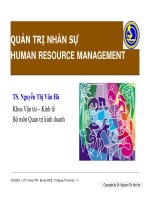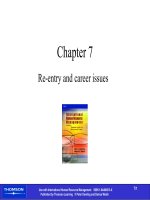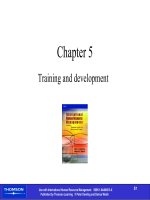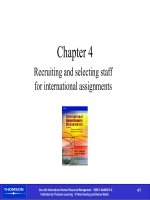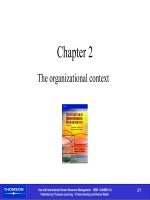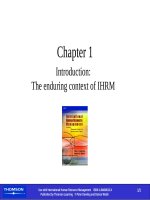Human Resource Management - Chapter 15 potx
Bạn đang xem bản rút gọn của tài liệu. Xem và tải ngay bản đầy đủ của tài liệu tại đây (176.05 KB, 15 trang )
© 2008 Prentice Hall, Inc.
© 2008 Prentice Hall, Inc.
All rights reserved.
All rights reserved.
PowerPoint Presentation by Charlie Cook
PowerPoint Presentation by Charlie Cook
The University of West Alabama
The University of West Alabama
1
Human Resource
Human Resource
Management
Management
ELEVENTH EDITION
ELEVENTH EDITION
G A R Y D E S S L E R
G A R Y D E S S L E R
Labor Relations and Collective Bargaining
Labor Relations and Collective Bargaining
Chapter
Chapter
15
15
Part 5 | Employee Relations
Part 5 | Employee Relations
© 2008 Prentice Hall, Inc. All
rights reserved.
15–2
After studying this chapter, you should be able to:
1.
1.
Give a brief history of the American labor movement.
Give a brief history of the American labor movement.
2.
2.
Discuss the main features of at least three major
Discuss the main features of at least three major
pieces of labor legislation.
pieces of labor legislation.
3.
3.
Present examples of what to expect during the union
Present examples of what to expect during the union
organizing drive and election.
organizing drive and election.
4.
4.
Describe five ways to lose an NLRB election.
Describe five ways to lose an NLRB election.
5.
5.
Illustrate with examples bargaining that is not in good
Illustrate with examples bargaining that is not in good
faith.
faith.
6.
6.
Develop a grievance procedure.
Develop a grievance procedure.
© 2008 Prentice Hall, Inc. All
rights reserved.
15–3
What Do Unions Want?
What Do Unions Want?
Union
Security
Improved wages,
hours, working
conditions, and
benefits
Aims of
Unions
© 2008 Prentice Hall, Inc. All
rights reserved.
15–4
Union Security
Union Security
Closed
Shop
Open
Shop
Union
Shop
Types of Union
Security
Agency
Shop
Maintenance
of
Membership
© 2008 Prentice Hall, Inc. All
rights reserved.
15–5
The AFL-CIO
The AFL-CIO
•
The American Federation of Labor and Congress of
The American Federation of Labor and Congress of
Industrial Organizations (AFL-CIO)
Industrial Organizations (AFL-CIO)
A voluntary federation of about 100 national and
A voluntary federation of about 100 national and
international labor unions in the United States.
international labor unions in the United States.
•
Structure of the AFL-CIO
Structure of the AFL-CIO
Local unions
Local unions
National unions
National unions
National federation
National federation
•
Change to Win Coalition
Change to Win Coalition
© 2008 Prentice Hall, Inc. All
rights reserved.
15–6
The Organizing Drive
The Organizing Drive
•
Employer Responses to Organizing
Employer Responses to Organizing
Can attack the union on ethical and moral grounds
Can attack the union on ethical and moral grounds
and cite the cost of union membership.
and cite the cost of union membership.
Cannot make promises of benefits.
Cannot make promises of benefits.
Cannot make unilateral changes in terms and
Cannot make unilateral changes in terms and
conditions of employment that were not planned to
conditions of employment that were not planned to
be implemented prior to the onset of union
be implemented prior to the onset of union
organizing activity.
organizing activity.
Can inform employees of their right to revoke their
Can inform employees of their right to revoke their
authorization cards.
authorization cards.
© 2008 Prentice Hall, Inc. All
rights reserved.
15–7
The Organizing Drive (cont’d)
The Organizing Drive (cont’d)
•
Union Activities During Organizing
Union Activities During Organizing
Unions can picket the company, subject to three
Unions can picket the company, subject to three
constraints:
constraints:
It must file a petition for an election within 30 days
It must file a petition for an election within 30 days
after the start of picketing.
after the start of picketing.
The firm cannot already be lawfully recognizing
The firm cannot already be lawfully recognizing
another union.
another union.
There cannot have been a valid NLRB election
There cannot have been a valid NLRB election
during the past 12 months.
during the past 12 months.
© 2008 Prentice Hall, Inc. All
rights reserved.
15–8
NLRB Hearing Officer’s Duties
NLRB Hearing Officer’s Duties
•
Determining if the record indicates there is enough
Determining if the record indicates there is enough
evidence to hold an election.
evidence to hold an election.
Did 30% of the employees in an appropriate
Did 30% of the employees in an appropriate
bargaining unit sign the authorization cards?
bargaining unit sign the authorization cards?
•
Deciding what the bargaining unit will be.
Deciding what the bargaining unit will be.
The bargaining unit is the group of employees that
The bargaining unit is the group of employees that
the union will be authorized to represent and bargain
the union will be authorized to represent and bargain
for collectively.
for collectively.
© 2008 Prentice Hall, Inc. All
rights reserved.
15–9
The Union Organizing Drive and Election
The Union Organizing Drive and Election
(cont’d)
(cont’d)
•
The Supervisor’s Role
The Supervisor’s Role
Unfair labor practices by supervisors:
Unfair labor practices by supervisors:
Could cause the NLRB to hold a new election
Could cause the NLRB to hold a new election
after the company has won a previous election.
after the company has won a previous election.
Could cause the company to forfeit the second
Could cause the company to forfeit the second
election and go directly to contract negotiation.
election and go directly to contract negotiation.
© 2008 Prentice Hall, Inc. All
rights reserved.
15–10
The Collective Bargaining Process
The Collective Bargaining Process
•
What Is Collective Bargaining?
What Is Collective Bargaining?
Both management and labor are required by law to
Both management and labor are required by law to
negotiate wages, hours, and terms and conditions of
negotiate wages, hours, and terms and conditions of
employment “in good faith.”
employment “in good faith.”
•
What Is Good Faith Bargaining?
What Is Good Faith Bargaining?
Both parties communicate and negotiate.
Both parties communicate and negotiate.
They match proposals with counterproposals in a
They match proposals with counterproposals in a
reasonable effort to arrive at an agreement.
reasonable effort to arrive at an agreement.
Neither party can compel the other to agree to a
Neither party can compel the other to agree to a
proposal or to make any specific concessions.
proposal or to make any specific concessions.
© 2008 Prentice Hall, Inc. All
rights reserved.
15–11
Classes of Bargaining Items
Classes of Bargaining Items
Mandatory
Items
Illegal
Items
Categories of
Bargaining Items
Voluntary
Items
© 2008 Prentice Hall, Inc. All
rights reserved.
15–12
Impasses, Mediation, and Strikes
Impasses, Mediation, and Strikes
•
An Impasse
An Impasse
Usually occurs because one party is demanding
Usually occurs because one party is demanding
more than the other will offer.
more than the other will offer.
Sometimes an impasse can be resolved through
Sometimes an impasse can be resolved through
a third party—a disinterested person such as a
a third party—a disinterested person such as a
mediator or arbitrator.
mediator or arbitrator.
If the impasse is not resolved:
If the impasse is not resolved:
The union may call a work stoppage, or strike, to
The union may call a work stoppage, or strike, to
put pressure on management.
put pressure on management.
Management may lock out employees.
Management may lock out employees.
© 2008 Prentice Hall, Inc. All
rights reserved.
15–13
Strikes
Strikes
Economic Strike
Unfair Labor Practice
Strike
Wildcat Strike
Sympathy Strike
Types of Strikes
© 2008 Prentice Hall, Inc. All
rights reserved.
15–14
Grievances
Grievances
•
Grievance
Grievance
Any factor involving
Any factor involving
wages, hours, or
wages, hours, or
conditions of employment
conditions of employment
that is used as a complaint
that is used as a complaint
against the employer.
against the employer.
•
Sources of Grievances
Sources of Grievances
Discipline
Discipline
Seniority
Seniority
Job evaluations
Job evaluations
Work assignments
Work assignments
Overtime
Overtime
Vacations
Vacations
Incentive plans
Incentive plans
Holiday pay
Holiday pay
Problem employees
Problem employees
© 2008 Prentice Hall, Inc. All
rights reserved.
15–15
K E Y T E R M S
closed shop
closed shop
union shop
union shop
agency shop
agency shop
open shop
open shop
right to work
right to work
Norris-LaGuardia Act (1932)
Norris-LaGuardia Act (1932)
National Labor Relations (or Wagner) Act
National Labor Relations (or Wagner) Act
National Labor Relations Board (NLRB)
National Labor Relations Board (NLRB)
Taft-Hartley Act (1947)
Taft-Hartley Act (1947)
national emergency strikes
national emergency strikes
Landrum-Griffin Act (1959)
Landrum-Griffin Act (1959)
union salting
union salting
authorization cards
authorization cards
bargaining unit
bargaining unit
decertification
decertification
collective bargaining
collective bargaining
good faith bargaining
good faith bargaining
voluntary bargaining items
voluntary bargaining items
illegal bargaining items
illegal bargaining items
mandatory bargaining items
mandatory bargaining items
impasse
impasse
mediation
mediation
fact finder
fact finder
arbitration
arbitration
strike
strike
economic strike
economic strike
unfair labor practice strike
unfair labor practice strike
wildcat strike
wildcat strike
sympathy strike
sympathy strike
picketing
picketing
corporate campaign
corporate campaign
boycott
boycott
inside games
inside games
lockout
lockout
injunction
injunction
grievance
grievance
